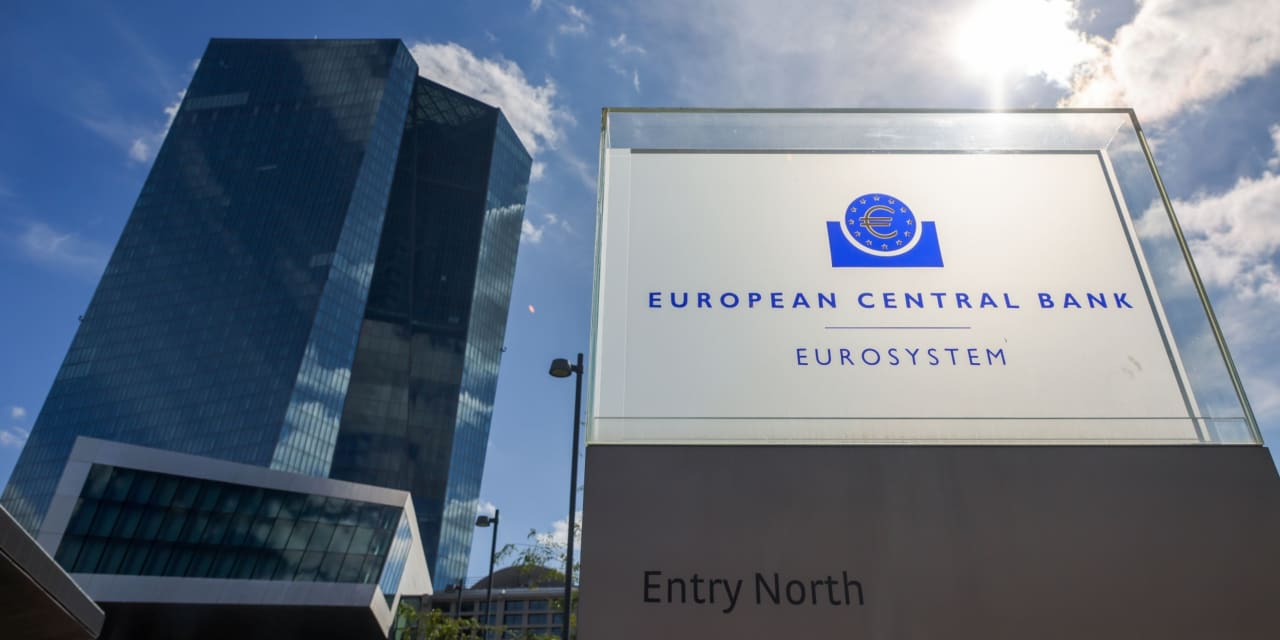Central banks in Europe have trailed the Federal Reserve in the interest-rate hiking cycle that started almost two years ago. Despite that, it’s now possible Europe could get a jump on the U.S. when it comes to cutting rates.
According to central bank forecasts, growth will be more sluggish in Europe over the next year. Momentum in the latest data shows inflation cooling much faster on the other side of the Atlantic, while the U.S. economy has been surprisingly strong. As a result, and contrary to expectations just a few months ago, the European Central Bank and the Bank of England may actually be in a position to cut interest rates before the Fed.
On Sept. 29, the euro-area inflation rate dropped dramatically, to 4.3%, the lowest since October 2021. That’s down from 5.2% in August and below economists’ expectations. A few weeks earlier, a bigger-than-anticipated drop in United Kingdom inflation, to 6.7%, gave the Bank of England room to hold off on an expected rate increase.
Both the euro zone and the U.K. target 2% inflation. That’s a way off still, but inflation rates are falling nicely, and since the targets are for the medium term—two to three years—it might be possible for the central banks to begin pondering cutting before reaching 2%. Getting it down to 4% could well be enough if the economy weakens, which could happen in the next six months.
True, few economists believe that Europe will start cutting first. But perceptions have changed so rapidly recently that it isn’t inconceivable. Six months ago, most economists said the Fed could be cutting rates in the fourth quarter, while Europe wrestled with an inflation that refused to subside. Since then, the U.S. economy has stayed strong while European inflation has begun to melt away.
U.S. inflation has slowed, but not as quickly as it had. In fact, it rose to 3.7% in August from 3.2% in July. At the same time, U.S. growth has been showing signs of strength, with the Oct. 6 jobs report suggesting surprising labor market resilience.
“A few months back, it looked like Europe had a much bigger inflation problem,” Hugh Gimber, a strategist at J.P. Morgan Asset Management, tells Barron’s. “Now, we’re seeing energy effects in Europe bringing headline inflation down, when actually the U.S. is starting to pick back up again.”
Many economists argue that the Fed has more room to loosen policy because it lifted rates faster and higher, especially if, as some predict, the U.S. economy contracts in the next few quarters. That’s not what the Fed is forecasting. But as the latest spike in Treasury yields shows, expectations are changing.
“The higher-for-longer mantra has really hit home because U.S. economic data have been so resilient,” says Jane Foley, a currency strategist at Rabobank. “The market has really pushed back expectations for the first Fed cut.”
In many ways, the Fed, the Bank of England, and the European Central Bank are roughly in the same place. They’re near the top of the rate-hiking cycle. All are promising to keep rates higher for longer to ensure that inflation is quelled. Although the ECB’s only goal is inflation, that message has more resonance in the U.S.
Markets are less certain that central banks in Europe will actually keep rates higher, at least compared with the U.S. That helps explain why the dollar has been strong against European currencies—the British pound has dropped 4.9% against the greenback in the past three months, while the euro has fallen 3.8%.
Recent revisions in economic projections point to a weakening Europe. The ECB now sees 0.7% growth this year and 1% next year—down 0.2 points and 0.5 points, respectively, from their June forecasts. The BOE also lowered its growth forecasts in August, and the U.K. is expected to be one of the weakest performers among advanced economies, according to the Organization for Economic Cooperation and Development.
By contrast, the Fed raised its projections for growth at its last meeting, seeing the U.S. economy expanding 2.1% this year and 1.5% next year, up from 1% and 1.1%, respectively, in June. That’s substantially higher than growth in Europe.
Germany, the powerhouse of Europe, is a particular problem. China’s tepid recovery this year from Covid lockdowns has subdued trade, and the continuing war in Ukraine raises the possibility of another energy crisis. The OECD sees Germany contracting 0.2% this year, the second-worst performance among its 30 members, trailing only Argentina.
Many economists say it’s likely that Europe will cut rates next year at about the same time as the Fed, or just after. Much will depend on how expectations for growth and inflation develop in the next few months. “I can imagine a world in which the ECB cuts in six months’ time, but for that world to materialize, you would need a hard landing,” says Mark Wall, chief European economist at Deutsche Bank. “But I don’t see a hard landing; I see the economy stagnating.”
The pressure to spur lagging growth will be great—a reality for all central banks. “A year ago, central banks would have accepted a hard landing as collateral damage for getting inflation down,” says James Smith, an economist at ING. “With inflation now coming down, sensitivity is shifting.”
Meanwhile, the Fed’s dual focus on prices and employment probably doesn’t matter, says J.P. Morgan’s Gimber. “It comes out in the wash,” since weaker growth normally goes hand in hand with slower inflation.
For now, U.S. investors are rightly focused on how high Fed rates go. Don’t be surprised if Europe jumps the line to cut rates first.
Write to Brian Swint at brian.swint@barrons.com
Read the full article here













Leave a Reply